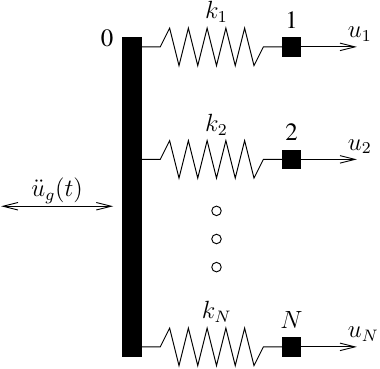OpenSees Cloud
OpenSees AMI
Multi-Threaded SDF Analysis
Original Post - 25 Nov 2022 - Michael H. Scott
Show your support at Buy Me a Coffee.
A previous post
showed that, when compared to a couple of brute force
approaches, using the sdfResponse command is the most computationally
efficient approach to generating an earthquake response spectrum.
During an OpenSees Cafe, Dr. Silvia Mazzoni suggested taking a more
intelligent approach by “batching” the brute force SDF analyses. Instead
of analyzing one oscillator at a time, create all the oscillators in a
single model and shake all the oscillators in a single analysis. Would
this multi-threading (shown below) be faster than using the sdfResponse
approach from the previous post?
import openseespy.opensees as ops
dTn = 0.02
Tno = dTn
Tnf = 3.0
ops.wipe()
ops.model('basic','-ndm',1,'-ndf',1)
ops.timeSeries('Path',1,'-dt',0.02,'-filePath','tabasFN.txt')
ops.pattern('UniformExcitation',1,1,'-accel',1)
Tgm = 30.0
i = 0
Tn = Tno
ops.node(0,0); ops.fix(0,1)
while Tn <= Tnf:
i += 1
ops.node(i,0); ops.mass(i,1.0) # m = 1
ops.uniaxialMaterial('Elastic',i,(2*pi/Tn)**2) # k = m*omega**2
ops.element('zeroLength',i,0,i,'-mat',i,'-dir',1)
Tn += dTn
ops.recorder('EnvelopeNode','-file','dispAll.out','-nodeRange',1,i,'-dof',1,'disp')
ops.system('Diagonal')
ops.analysis('Transient')
dt = 0.02
N = int(Tgm/dt)
ops.analyze(N,dt)
The resulting model is multiple SDF oscillators connected to one base node.

Because the SDFs are uncoupled from each other, this is perhaps the only
acceptable use of the Diagonal solver outside of explicit time
integration with coupled systems. Also, note that the maximum
displacement of each oscillator is dumped to a single file using the
-nodeRange option to the EnvelopeNode recorder.
I didn’t make any plots, so you’ll have to take my word for it: the
sdfResponse approach generates an elastic response spectrum about 2-3
times faster than the batched SDF approach. Note that the sdfResponse
approach was 6-8 times faster than brute force approaches from the
previous post–that
is a win in and of itself. Still, the overhead of a
proper finite element analysis dominates SDF analysis.
The batched SDF approach is a good idea in many situations though,
particularly using nonlinear hysteretic models where the oscillators can
do their thing simultaneously or if you have simple (elastic or
inelastic) systems that sdfResponse cannot handle, e.g., a two DOF SSI
system. However, the drawbacks of “multi-threading” and SDF analysis are
1) the analysis cannot proceed to the next time step until all nonlinear
oscillators have reached equilibrium and 2) non-convergence of one
nonlinear oscillator will cause the analysis to stop for all
oscillators.